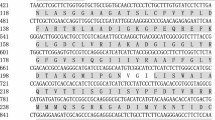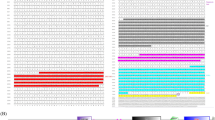Abstract
Ribosomal protein S6 kinases (S6Ks) are key targets downstream of the mechanistic target of rapamycin (mTOR) signaling pathway that are activated by mTOR complex 1 phosphorylation to promote protein synthesis, and are involved in muscle growth and pathology. In this study, we cloned a 1560-base pair (bp) complementary DNA sequence encoding a unique S6K1, designated EsS6K1, in the Chinese mitten crab Eriocheir sinensis. EsS6K1 contains a 54-bp 5′ untranslated region, a 246-bp 3′ untranslated region and a 1260-bp coding sequence that encodes 419 amino acids. EsS6K1 contains a conserved kinase domain, a TOR signaling motif, and a turn motif; it lacks a C-terminal autoinhibitory domain, and the conventional threonine in the hydrophobic motif is replaced with serine. Real-time quantitative reverse transcription–polymerase chain reaction experiments showed that EsS6K1 expression was highest in the ovaries, followed by the testes and the eyestalks, in mature crabs. In juvenile crabs, the relative messenger RNA levels of EsS6K1 in the claw, walking leg and abdominal muscles were significantly higher in the late premolt (D3-4) stage than in the intermolt (C) stage. After ecdysis, the expression of EsS6K1 in the walking leg and abdominal muscles declined to the level in the C stage, but the expression in claw muscles remained as high as that in the D3-4 stage. The findings showed that EsS6K1 likely plays roles in muscle changes during crustacean molting. These results provide valuable insights into the mechanism underlying crustacean muscle growth induced by molting.







Similar content being viewed by others
References
Abuhagr AM, Maclea KS, Chang ES, Mykles DL (2014) Mechanistic target of rapamycin (mTOR) signaling genes in decapod crustaceans: cloning and tissue expression of mTOR, Akt, Rheb, and p70 S6 kinase in the green crab Carcinus maenas, and blackback land crab Gecarcinus lateralis. Comp Biochem Physiol A: Mol Integr Physiol 168:25–39
Aguilar V, Alliouachene S, Sotiropoulos A, Sobering A, Athea Y, Djouadi F (2007) S6 kinase deletion suppresses muscle growth adaptations to nutrient availability by activating AMP kinase. Cell Metab 5:476–487
Banerjee P, Ahmad MF, Grove JR, Kozlosky C, Price DJ, Avruch J (1990) Molecular structure of a major insulin/mitogen-activated 70-kDa S6 protein kinase. Proc Natl Acad Sci USA 87:8550–8554
Burnett PE, Barrow RK, Cohen NA, Snyder SH, Sabatini DM (1998) RAFT1 phosphorylation of the translational regulators p70 S6 kinase and 4E-BP1. Proc Natl Acad Sci USA 95:1432–1437
Cano M, Ayala A, Marotta F, Arguelles S (2017) Application of kinase inhibitors for anti-aging intervention. Curr Pharm Des 23:4351–4368
Chung JS, Zmora N, Katayama H, Tsutsui N (2010) Crustacean hyperglycemic hormone (CHH) neuropeptidesfamily: functions, titer, and binding to target tissues. Gen Comp Endocrinol 166:447–454
Dennis PB, Pullen N, Pearson RB, Kozma SC, Thomas G (1998) Phosphorylation sites in the autoinhibitory domain participate in p70(S6K) activation loop phosphorylation. J Biol Chem 273:14845–14852
Dittel AI, Epifanio CE (2009) Invasion biology of the Chinese mitten crab Eriochier sinensis: a brief review. J Exp Mar Biol Ecol 374:79–92
Easley CAT, Ben-Yehudah A, Redinger CJ, Oliver SL, Varum ST, Eisinger VM, Carlisle DL, Donovan PJ, Schatten GP (2010) mTOR-mediated activation of p70 S6K induces differentiation of pluripotent human embryonic stem cells. Cell Reprogram 12:263–273
El Haj AJ (1999) Regulation of muscle growth and sarcomeric protein gene expression over the intermolt cycle. Am Zool 39:570–579
El Haj A, Clarke S, Harrison P, Chang E (1996) In vivo muscle protein synthesis rates in the American lobster Homarus americanus during the moult cycle and in response to 20-hydroxyecdysone. J Exp Biol 199:579–585
Hodson N, Philp A (2019) The importance of mTOR trafficking for human skeletal muscle translational control. Exerc Sport Sci Rev 47:46–53
Ilha J, Espirito-Santo CC, Freitas GR (2018) mTOR signaling pathway and protein synthesis: from training to aging and muscle autophagy. Adv Exp Med Biol 1088:139–151
Ismail SZM, Mykles DL (1992) Differential molt-induced atrophy in the dimorphic claws of male fiddler crabs. J Exp Zool 263:18–31
Kuballa AV, Holton TA, Paterson B, Elizur A (2011) Moult cycle specific differential gene expression profiling of the crab Portunus pelagicus. BMC Genom 12:147
Lee JE, Lim MS, Park JH, Park CH, Koh HC (2016) S6K promotes dopaminergic neuronal differentiation through PI3K/Akt/mTOR-dependent signaling pathways in human neural stem cells. Mol Neurobiol 53:3771–3782
Lee-Fruman KK, Kuo CJ, Lippincott J, Terada N, Blenis J (1999) Characterization of S6K2, a novel kinase homologous to S6K1. Oncogene 18:5108–5114
Magnuson B, Ekim B, Fingar DC (2012) Regulation and function of ribosomal protein S6 kinase (S6K) within mTOR signalling networks. Biochem J 441:1–21
Mykles DL (1997) Crustacean muscle plasticity: molecular mechanisms determining mass and contractile properties. Comp Biochem Physiol B Biochem Mol Biol 117:367–378
Mykles DL (1999) Proteolytic processes underlying molt-induced claw muscle atrophy in decapod crustaceans. Am Zool 39:541–551
Mykles DL, Medler S (2015) Skeletal muscle differentiation, growth, and plasticity. In: Chang ES, Thiel M (eds) Natural history of Crustacea. Oxford University Press, Oxford, pp 134–167
Mykles DL, Skinner DM (1981) Preferential loss of thin filaments during molt-induced atrophy in crab claw muscle. J Ultrastruct Res 75:314–325
Mykles DL, Skinner DM (1990) Athophy of crustacean somatic muscle and the proteinases that do the job. A review. J Crustacean Biol 10:577
Nakatsuji T, Keino H, Tamura K, Yoshimura S, Kawakami T, Aimoto S, Sonobe H (2000) Changes in the amounts of the molt-inhibiting hormone in sinus glands during the molt cycle of the American crayfish Procambarus clarkii. Zool Sci 17:1129–1136
Pearce LR, Komander D, Alessi DR (2010) The nuts and bolts of AGC protein kinases. Nat Rev Mol Cell Bio 11:9–22
Pende M (2006) mTOR, Akt, S6 kinases and the control of skeletal muscle growth. Bull Cancer 93:E39–E43
Saitoh M, ten Dijke P, Miyazono K, Ichijo H (1998) Cloning and characterization of p70(S6K beta) defines a novel family of p70 S6 kinases. Biochem Biophys Res Commun 253:470–476
Santiago J, Sturgill TW (2001) Identification of the S6 kinase activity stimulated in quiescent brine shrimp embryos upon entry to preemergence development as p70 ribosomal protein S6 kinase: isolation of Artemia franciscana p70S6k cDNA. Biochem Cell Biol 79:141–152
Schalm SS, Blenis J (2002) Identification of a conserved motif required for mTOR signaling. Curr Biol 12:632–639
Schmiege DL, Ridgwa RL, Moffett SB (1992) Ultrastructure of autotomy-induced atrophy of muscles in the crab Carcinus maenas. Can J Zool 72:841–851
Thomas G (2002) The S6 kinase signaling pathway in the control of development and growth. Biol Res 35:305–313
Tian Z, Kang X, Mu S (2012) The molt stages and the hepatopancreas contents of lipids, glycogen and selected inorganic elements during the molt cycle of the Chinese mitten crab Eriocheir sinensis. Fish Sci 78:67–74
Wang C, Li C, Li S (2010) Mitochondrial DNA-inferred population structure and demographic history of the mitten crab Eriocheir sensu stricto found along the coast of mainland China. Mol Ecol 17:3515–3527
Weng QP, Kozlowski M, Belham C, Zhang A, Comb MJ, Avruch J (1998) Regulation of the p70 S6 kinase by phosphorylation in vivo. Analysis using site-specific anti-phosphopeptide antibodies. J Biol Chem 273:16621–16629
West JM (1997) Ultrastructural and contractile activation properties of crustacean muscle fibres over the moult cycle. Comp Biochem Physiol B Biochem Mol Biol 117B:333–345
West JM, Humphris DC, Stephenson DG (1995) Characterization of ultrastructural and contractile activation properties of crustacean Cherax destructor muscle fibres during claw regeneration and moulting. J Muscle Res Cell Motil 16:267–284
Whiteley NM, El Haj AJ (1997) Regulation of muscle gene expression over the moult in crustacea. Comp Biochem Physiol B 117:323–331
Wittmann AC, Benrabaa SAM, Lopez-Ceron DA, Chang ES, Mykles DL (2018) Effects of temperature on survival, moulting, and expression of neuropeptide and mTOR signalling genes in juvenile Dungeness crab Metacarcinus magister. J Exp Biol 221:5. https://doi.org/10.1242/jeb.187492
You JS, McNally RM, Jacobs BL, Privett RE, Gundermann DM, Lin KH, Steinert ND, Goodman CA and Hornberger TA (2018) The role of raptor in the mechanical load-induced regulation of mTOR signaling, protein synthesis, and skeletal muscle hypertrophy. FASEB J:fj201801653RR
Acknowledgements
This work was funded by the National Natural Science Foundation of China (31572635), the Key Supporting Subject of Ecology of Shaoguan University (230079030101) and the Key Scientific Research Project of Shaoguan University (SZ2018KJ04). We would like to thank Prof. Yongxu Cheng for kindly arranging the animal sampling.
Author information
Authors and Affiliations
Corresponding author
Additional information
Publisher's Note
Springer Nature remains neutral with regard to jurisdictional claims in published maps and institutional affiliations.
Rights and permissions
About this article
Cite this article
Tian, Z., Lin, G. & Jiao, C. Identification of a S6 kinase transcript in the Chinese mitten crab Eriocheir sinensis and its molting-related expression in muscle tissues. Fish Sci 85, 737–746 (2019). https://doi.org/10.1007/s12562-019-01326-y
Received:
Accepted:
Published:
Issue Date:
DOI: https://doi.org/10.1007/s12562-019-01326-y




